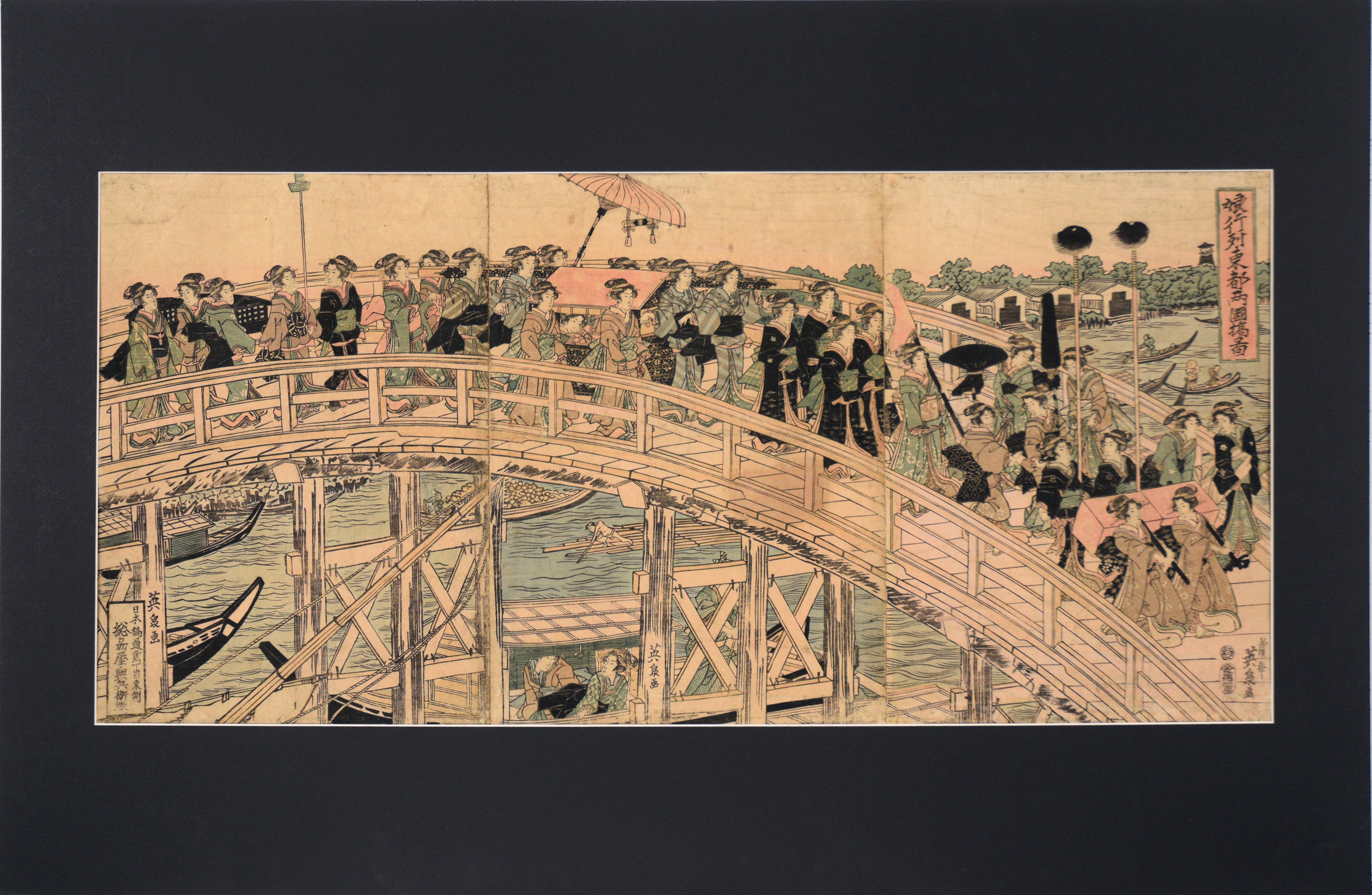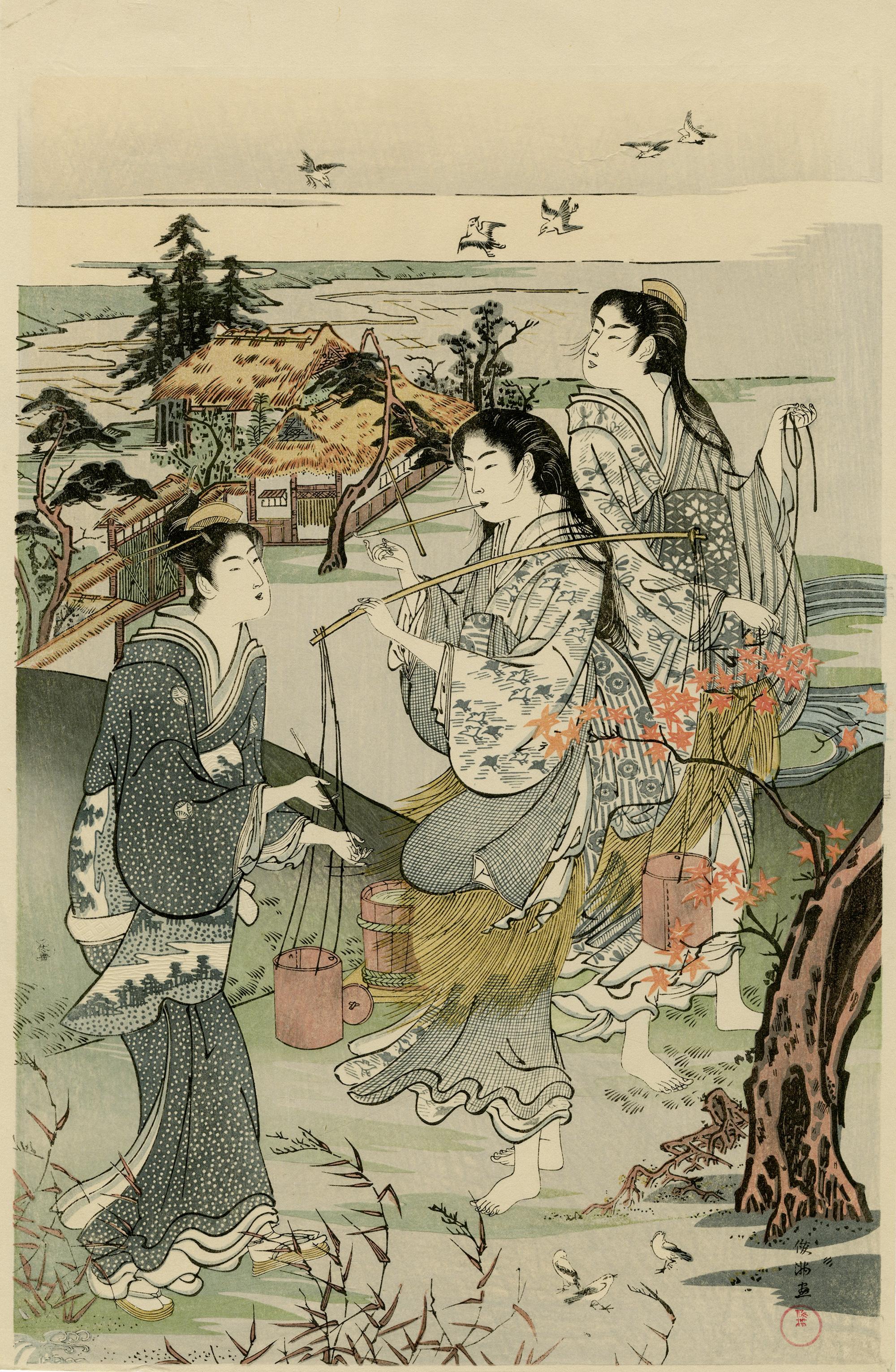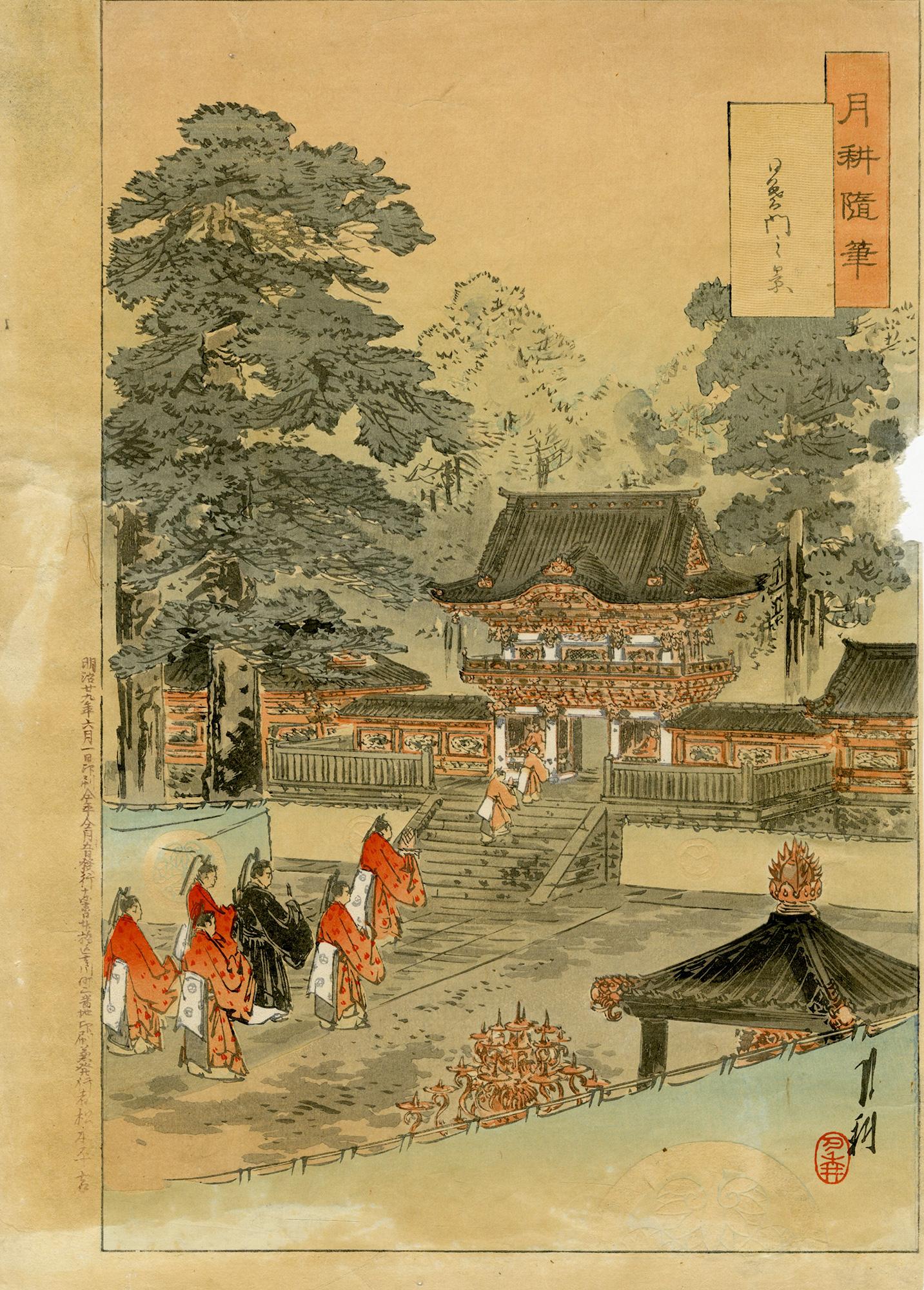Items Similar to Kintai Bridge at Iwakuni in Suo Province (Suo iwakuni kintai-bashi), 1859
Want more images or videos?
Request additional images or videos from the seller
1 of 2
Hiroshige IIKintai Bridge at Iwakuni in Suo Province (Suo iwakuni kintai-bashi), 18591859
1859
About the Item
Utagawa Hiroshige II (1829-1869), 'Kintai Bridge at Iwakuni in Suo Province' (Suo iwakuni kintai-bashi), from the series 'One Hundred Views of Famous Places in the Provinces' (Shokoku meisho hyakkei). woodblock print, 1859.
A fine, early impression, with rich, fresh colors, mica in the snow, and pronounced woodgrain, on cream Japan paper; the full sheet, in original condition, uncleaned and without repairs.
Signed Hiroshige ga, with publisher's seal Uoei of Uoya Eikichi, censor's and date seal Goat 11 aratame (1859).
Oban tate-e; image size 14 3/4 x 9 15/16 inches (506 x 375 mm).
The Kintai-bashi (Bridge of the Brocade Sash) crosses the Nishikawa (Brocade River) in Iwakuni. It was built in 1673 with five arches supported by wood pilings under the arches near the shore and four massive stone pilings engineered to withstand annual flooding that had destroyed earlier bridges with wood pilings. The original survived until 1950, when it was destroyed by a typhoon—the beloved bridge was reconstructed in 1953 by Iwakuni City.
The Kintai-bashi's graceful form, poetic name, and acclaimed feat of engineering made it one of the most famous bridges in Japan's provinces. Twenty-five years earlier, Katsushika Hokusai (1760-1849) included the bridge in his series, 'Unusual Views of Famous Bridges in the Provinces', depicting figures crossing the looping span during a rain shower.
Exhibited:
'Near and Far: Landscapes by Japanese Artists', The Clark Center for Japanese Art and Culture, Hanford, California, January 6 - April 20, 2013
Other impressions of this celebrated work are held in the collections of the Art Institute of Chicago, Asian Art Museum, British Museum, Clark Art Institute, Fine Arts Museums of San Francisco, Harvard Art Museums, and the Museum of Fine Arts Boston.
- Creator:Hiroshige II (1829 - 1869, Japanese)
- Creation Year:1859
- Dimensions:Height: 14.75 in (37.47 cm)Width: 9.94 in (25.25 cm)
- Medium:
- Movement & Style:
- Period:
- Condition:
- Gallery Location:Myrtle Beach, SC
- Reference Number:
About the Seller
5.0
Recognized Seller
These prestigious sellers are industry leaders and represent the highest echelon for item quality and design.
Platinum Seller
These expertly vetted sellers are 1stDibs' most experienced sellers and are rated highest by our customers.
Established in 1995
1stDibs seller since 2016
258 sales on 1stDibs
Typical response time: 1 hour
Associations
International Fine Print Dealers Association
- ShippingRetrieving quote...Ships From: Myrtle Beach, SC
- Return PolicyA return for this item may be initiated within 7 days of delivery.
More From This SellerView All
- 'Hill' — 1930s American ModernismBy Paul LandacreLocated in Myrtle Beach, SCPaul Landacre, 'Hill', wood engraving, 1936, edition 60 (only 54 printed); only 2 impressions printed in a second edition of 150. Signed, titled, and numbered '49/60' in pencil. Wien...Category
1930s American Modern Landscape Prints
MaterialsWoodcut
- 'Taos Placita' — 1940s Southwest RegionalismBy Gustave BaumannLocated in Myrtle Beach, SCGustave Baumann, 'Taos Placita', color woodcut, 1947, edition 125. Baumann 132. Signed, titled, and numbered '20-125' in pencil; with the artist’s Hand-in-Heart chop. A superb, richly-inked impression, with fresh colors, on fibrous oatmeal wove paper; the full sheet with margins (2 to 3 1/8 inches); slight rippling at the left sheet edge, in excellent condition. Matted to museum standards, unframed. Image size 9 5/8 x 11 1/4 inches (244 x 286 mm); sheet size 13 1/4 x 17 inches (337 x 432 mm). Collections: New Mexico Museum of Art, Phoenix Art Museum, Wichita Art Museum. ABOUT THE ARTIST Gustave Baumann (1881-1971) was a renowned printmaker and a leading figure of the American color woodcut revival whose exquisite craftsmanship and vibrant imagery captured the essence of the Southwest. "A brilliant printmaker, Baumann brought to the medium a full mastery of the craft of woodworking that he acquired from his father, a German cabinetmaker. This craftsmanship was coupled with a strong artistic training that resulted in the handsome objects we see in the exhibition today. After discovering New Mexico in 1918, Baumann began to explore in his woodblock prints of this period the light. color, and architectural forms of that landscape. His prints of this period are among the most beautiful and poetic images of the American West." —Lewis I. Sharp, Director, Denver Art Museum Baumann, the son of a craftsman, immigrated to the United States from Germany with his family when he was ten, settling in Chicago. From 1897 to 1904, he studied in the evenings at the Art Institute of Chicago, working in a commercial printmaking shop during the day. In 1905, he returned to Germany to attend the Kunstwerbe Schule in Munich, where he decided on a career in printmaking. He returned to Chicago in 1906 and worked for a few years as a graphic designer of labels. Baumann made his first prints in 1909 and exhibited them at the Art Institute of Chicago the following year. In 1910, he moved to the artists’ colony in Nashville, Indiana, where he explored the creative and commercial possibilities of a career as a printmaker. In 1915, he exhibited his color woodcuts at the Panama-Pacific International Exposition in San Francisco, winning the gold medal. Among Baumann’s ongoing commercial activities was his work for the Packard Motor Car Company from 1914 to 1920 where he produced designs, illustrations, and color woodcuts until 1923. In 1919, Baumann’s printmaking work dominated the important exhibition of American color woodcuts at the Detroit Institute of Arts. Twenty-six of his prints were included, far more than the works of any other artist. A set of his blocks, a preparatory drawing, and seven progressive proofs complemented the exhibition. That same year, Baumann worked in New York and, over the summer, in Provincetown, Massachusetts. His airy images of Cape Cod employed soft, pastel colors and occasionally showed the influence of the white-line woodcut technique. Many of his Chicago artist friends had traveled to the southwest, and Baumann became intrigued by their paintings, souvenirs, and stories of an exotic place named Taos, New Mexico. In the summer of 1918, he spent the summer in Taos sketching and painting before visiting Santa Fe. Paul Walter, the director of the Museum of New Mexico, offered him a studio in the museum's basement. Inspired by the rugged beauty of the Southwest—the vibrant colors and dramatic landscapes of the region became a central theme in his work, influencing his artistic style and subject matter for the remainder of his career. Later in the decade, he traveled to the West Coast and made prints of California landscape. Baumann's prints became synonymous with the Southwest, capturing the spirit of its place in America's identity with a unique sense of authenticity and reverence. His iconic images of desert vistas, pueblo villages, and indigenous cultures served as visual tributes to the region's rich cultural heritage, earning him a dedicated following among collectors and curators alike. A true craftsman and artist, Baumann completed every step of the printmaking process himself, cutting each block, mixing the inks, and printing every impression on the handmade paper he selected. His dedication to true craftsmanship and his commitment to preserving the integrity of his artistic vision earned him widespread acclaim and recognition within the art world. About the vibrant colors he produced, Baumann stated, “A knowledge of color needs to be acquired since they don’t all behave the same way when ground or mixed...careful chemistry goes into the making of colors, with meticulous testing for permanence. While complicated formulae evolve new colors, those derived from Earth and metal bases are still the most reliable.” In the 1930s, Baumann became interested in puppet theater. He designed and carved his own marionettes and established a little traveling company. From 1943 to 1945, the artist carved an altarpiece for the Episcopal Church of the Holy Faith in Santa Fe. In 1952, a retrospective exhibition of his prints was mounted at the New Mexico Museum of Fine Arts. Throughout his prolific career, Baumann executed nearly four hundred color woodcuts. Baumann’s woodcuts...Category
1940s American Modern Landscape Prints
MaterialsWoodcut
- 'Garyu no sakura' (The Lying Dragon Cherry Tree, Gifu) — Contemporary JapaneseLocated in Myrtle Beach, SCHajime Namiki, 'Garyu no sakura (The Lying Dragon Cherry Tree, Gifu)', color woodcut, 2003, edition 200. Signed in pencil and with the artist’s red seal....Category
Early 2000s Contemporary Landscape Prints
MaterialsWoodcut
- 'Laguna Cove' — 1930s American ModernismBy Paul LandacreLocated in Myrtle Beach, SCPaul Landacre, 'Laguna Cove', wood engraving, 1935; edition 60 (16 printed), 2nd edition 150 (6 printed), Woodcut Society 200, Wien 247. Signed and titled in pencil. A brilliant, black impression, on cream wove Japan, with full margins (3/4 to 1 3/4 inches), in excellent condition. Archivally matted to museum standards, unframed. This impression is from the edition published for the Twentieth Presentation Print of the Woodcut Society, 1941. Printed by Torch Press, Cedar Rapids. Literature: Reproduced in 'James Swann...Category
1930s American Modern Landscape Prints
MaterialsWoodcut
- 'Chion-in Temple Gate' from 'Eight Scenes of Cherry Blossoms' — Jizuri SealBy Hiroshi YoshidaLocated in Myrtle Beach, SCHiroshi Yoshida, 'Chion-in Temple Gate (Sunset)' from the series 'Eight Scenes of Cherry Blossoms (Sakura hachi dai: Sakura mon)', color woodblock print, 1935. Signed in brush 'Yoshida' and in pencil 'Hiroshi Yoshida'. A superb, early impression, with fresh colors; the full sheet with margins, on cream Japan paper; an area of slight toning in the top right sheet corner, not affecting the image, otherwise in excellent condition. Marked with a jizuri (self-printed) seal, upper left margin. Self-published by the artist. Image size 9 5/8 x 14 3/4 inches (444 x 375 mm); sheet size 10 7/8 x 16 inches (276 x 406 mm). Archivally sleeved, unmatted. Provenance: M. Nakazawa, Tokyo. Literature: Japanese Landscapes of the 20th century (Hotei Publishing calendar), 2001, May. Collections: Honolulu Museum of Art, Museum of Fine Arts, Boston. ABOUT THE IMAGE Located in Kyoto, Chionin is the main temple of the Jodo sect of Japanese Buddhism, one of the most popular Buddhist sects in Japan, having millions of followers. The Sanmon Gate, Chionin's entrance gate, standing 24 meters tall and 50 meters wide, it is the largest wooden temple gate in Japan and dates back to the early 1600s. Behind the gate, a wide set of stairs leads to the main temple grounds. ABOUT THE ARTIST Painter and printmaker Yoshida Hiroshi (1876-1950) is regarded as one of the greatest artists of the Japanese 'shin hanga' (New Print) movement. Yoshida was born as the second son of Ueda Tsukane in Kurume, Fukuoka Prefecture, a schoolteacher from an old samurai family. In 1891 he was adopted by his art teacher Yoshida Kasaburo in Fukuoka and took his surname. In 1893 he went to Kyoto to study painting, and the following year to Tokyo to join Koyama Shotaro's Fudosha private school; he also became a member of the Meiji Fine Arts Society. These institutions taught and advocated Western-style painting, greatly influencing Yoshida’s artistic development. In 1899 Yoshida had his first American exhibition at Detroit Museum of Art (now Detroit Institute of Art), making the first of many visits to the US and Europe. In 1902 he helped reorganize the Meiji Fine Arts Society, renaming it the Taiheiyo-Gakai (Pacific Painting...Category
1930s Showa Figurative Prints
MaterialsWoodcut
- The Beach at Kaiganji in Sanuki Province — Lifetime Impression, 1934By Kawase HasuiLocated in Myrtle Beach, SCThe Beach at Kaiganji in Sanuki Province (Sanuki Kaiganji no hama), from the series Collected Views of Japan II, Kansai Edition (Nihon fûkei shû II Kansai hen), woodblock print, 1934. A very fine, atmospheric impression, with fresh colors; the full sheet, in excellent condition. Signed 'Hasui' with the artist’s seal 'Kawase', lower left. Published by Watanabe Shozaburo with the Watanabe ‘D’ seal indicating an early impression printed between 1931 - 1941. Stamped faintly 'Made in Japan' in the bottom center margin, verso. Horizontal ôban; image size 9 3/8 x 14 1/4 inches (238 x 362 mm); sheet size approximately 10 5/16 x 15 1/2 inches ( 262 x 394 mm). Collections: Art Institute of Chicago; Austrian Museum of Applied Arts (Vienna); Honolulu Museum of Art; Museum of Fine Arts, Boston; National Museum in Warsaw; University of Wisconsin-Madison. ABOUT THE ARTIST “I do not paint subjective impressions. My work is based on reality...I can not falsify...(but) I can simplify…I make mental impressions of the light and color at the time of sketching. While coloring the sketch, I am already imagining the effects in a woodblock print.” — Kawase Hasui Hasui Kawase...Category
1930s Showa Landscape Prints
MaterialsWoodcut
You May Also Like
- "Plovers at Tamagawa" from "Six Jewel Rivers" - Woodblock Print on PaperLocated in Soquel, CA"Plovers at Tamagawa" from "Six Jewel Rivers" - Woodblock Print on Paper This print, sometimes titled "Chidori No Tamagawa" "Plovers at Tamagawa", is from the series Mu Tamagawa ("Six Views of Tama River", also known as "Six Jewel Rivers" or "Six Crystal Rivers") by Kubo Shunman...Category
Late 18th Century Edo Landscape Prints
MaterialsPaper, Ink, Woodcut
- Mitate of a Daimyo's Procession Crossing Ryogoku Bridge - Woodblock PrintBy Keisai EisenLocated in Soquel, CAMitate of a Daimyo's Procession Crossing Ryogoku Bridge - Woodblock Print Woodblock print of a procession by Keisai Eisen (Japanese, 1790–1848). Terrific triptych of a procession of...Category
Early 19th Century Edo Figurative Prints
MaterialsWoodcut, Rice Paper, Ink
- The Battle of Dan-no-ura in Yashima, Nagato Province in the First Year .....By Utagawa YoshitoraLocated in Middletown, NYThe Battle of Dan-no-ura in Yashima, Nagato Province in the First Year of the Bunji Era (1185) Tokyo c. 1830 Woodblock print (nishiki-e) with ink and hand-coloring in watercolor on handmade mulberry paper, 14 7/16 x 9 15/16 inches (367 x 252 mm), ōban tate-e, the full sheet. In good condition with some handling creases. Colors are fresh and extremely vibrant. The right panel from the triptych by Yoshitora depicting one of Japan's most storied naval battles. An impression of this work may be found in the permanent collection of the Honolulu Museum of Art. The great naval battle of Dan-no-ura in 1185 was the final climax in a long series of bitter wars between two powerful families in feudal Japan...Category
Early 19th Century Edo Figurative Prints
MaterialsHandmade Paper, Watercolor, Woodcut
- The Pilgrimage Procession to Kinryuzan Temple at Asakusa in the Eastern CapitalBy KuniyasuLocated in Soquel, CAJapanese Parade - Woodblock Print Japanese woodblock print by Utagawa Kuniyasu (歌川 国安) (Japan, 1794–1832). Japanese women, dressed in blue and red kimonos, are the focal point. A vi...Category
Mid-19th Century Edo Figurative Prints
MaterialsPaper, Ink, Woodcut
- Mu-TamagawaLocated in Middletown, NYWoodcut in ink with embossing and hand-coloring in watercolor on laid Japon paper, 16 x 10 inches (406 x 253 mm), ōban tate-e, full margins. Scattered handling wear and toning, other...Category
Late 19th Century Edo Portrait Prints
MaterialsHandmade Paper, Watercolor, Woodcut
- Toshogu ShrineLocated in Middletown, NYIn image of the Tokugawa family paying homage to Tosho-gu Shrine in Nikko. Tokyo: Matsuki Heikichi, 1896 Woodcut in ink with embossing and hand-coloring in watercolor on handmade m...Category
Late 19th Century Edo Figurative Prints
MaterialsHandmade Paper, Watercolor, Woodcut
Recently Viewed
View AllMore Ways To Browse
Wood Pile
Japanese Print Rain
Original Hokusai
Hokusai Original Print
Antique Japanese Woodblock Prints Hiroshige
Antique Showers
Hokusai Katsushika
Lawrence Josset
Le Remorqueur
Lech Ski Poster
Lena Liu
Lichtenstein Moonscape
Lilian May Miller
Linocuts Hand Tinted
Louis Conrad Rosenberg On Sale
Lucien Jonas
Luigi Kasimir San Francisco
Luigi Lucioni On Sale





